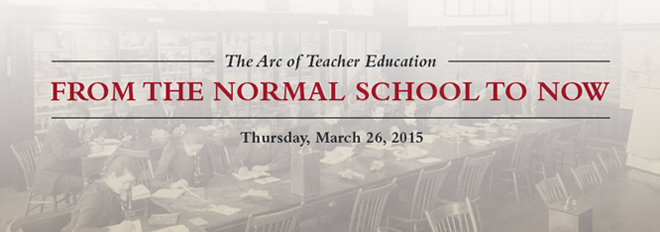Presentation Title
A Theory-Driven Reappraisal of the Historiography of Normal Schools
Session Name
Concurrent Session 1. Past as Prologue: The Early History
Start Date
26-3-2015 2:00 PM
End Date
26-3-2015 3:30 PM
Abstract
Mainstream historiography understates the importance of normal schools; as a result, historians cannot fully appreciate normal schools’ influence on institutional forms. We support this contention through a review of: 1) the description of normal schools in synthetic histories; 2) literature specifically on normal schools; and 3) a reappraisal of each using social theories that illuminate relationships between people, institutions, and society related to normal schools.
The dominant historiography of American higher education relegates the normal school to a discursive cul-de-sac whereby they offered roughly the same academic rigor as a high school and are quickly superseded by teachers colleges (Brubacher & Rudy, 1976; Rudolph, 1962). While recent literature acknowledges that normal schools expanded access for women and allowed for curricular innovation (Geiger, 2014; Thelin, 2011), mainstream historiography still underplays the normal school movement’s role in generating adaptive changes. Literature focused specifically on normal schools casts them as an attempt to democratize higher education and society (c.f. Ogren, 2005; Pacheo, 2013; Taylor, 2010).
Our reappraisal of normal school historiography utilizes three social theories. Institutional isomorphism contends that coercive, mimetic, and normative pressures lead normal schools to resemble universities (DiMaggio & Powell, 1983). Similarly, structuration supports the idea that social institutions become homogenous through repeated social practice (Giddens, 1979; Giddens & Pierson, 1998). Finally, postmodern theories—specifically organized anarchy and critical feminism—demonstrate the extent to which an institution’s goals are inherently ambiguous and change over time—clearly the case for normal schools (Manning, 2013; Scott & Davis, 2007).
Included in
A Theory-Driven Reappraisal of the Historiography of Normal Schools
Mainstream historiography understates the importance of normal schools; as a result, historians cannot fully appreciate normal schools’ influence on institutional forms. We support this contention through a review of: 1) the description of normal schools in synthetic histories; 2) literature specifically on normal schools; and 3) a reappraisal of each using social theories that illuminate relationships between people, institutions, and society related to normal schools.
The dominant historiography of American higher education relegates the normal school to a discursive cul-de-sac whereby they offered roughly the same academic rigor as a high school and are quickly superseded by teachers colleges (Brubacher & Rudy, 1976; Rudolph, 1962). While recent literature acknowledges that normal schools expanded access for women and allowed for curricular innovation (Geiger, 2014; Thelin, 2011), mainstream historiography still underplays the normal school movement’s role in generating adaptive changes. Literature focused specifically on normal schools casts them as an attempt to democratize higher education and society (c.f. Ogren, 2005; Pacheo, 2013; Taylor, 2010).
Our reappraisal of normal school historiography utilizes three social theories. Institutional isomorphism contends that coercive, mimetic, and normative pressures lead normal schools to resemble universities (DiMaggio & Powell, 1983). Similarly, structuration supports the idea that social institutions become homogenous through repeated social practice (Giddens, 1979; Giddens & Pierson, 1998). Finally, postmodern theories—specifically organized anarchy and critical feminism—demonstrate the extent to which an institution’s goals are inherently ambiguous and change over time—clearly the case for normal schools (Manning, 2013; Scott & Davis, 2007).
